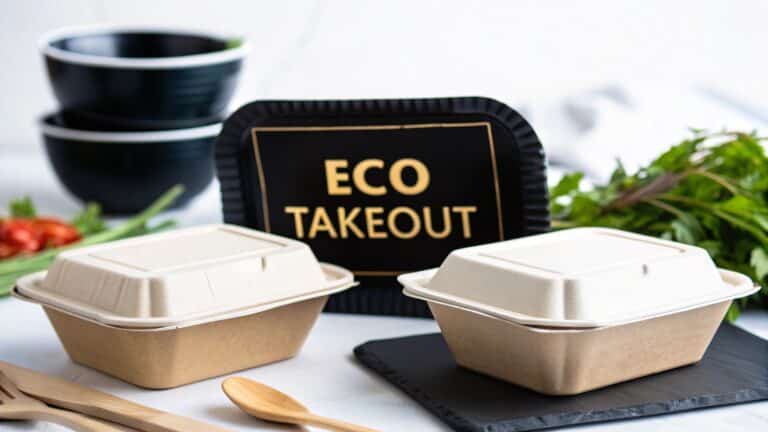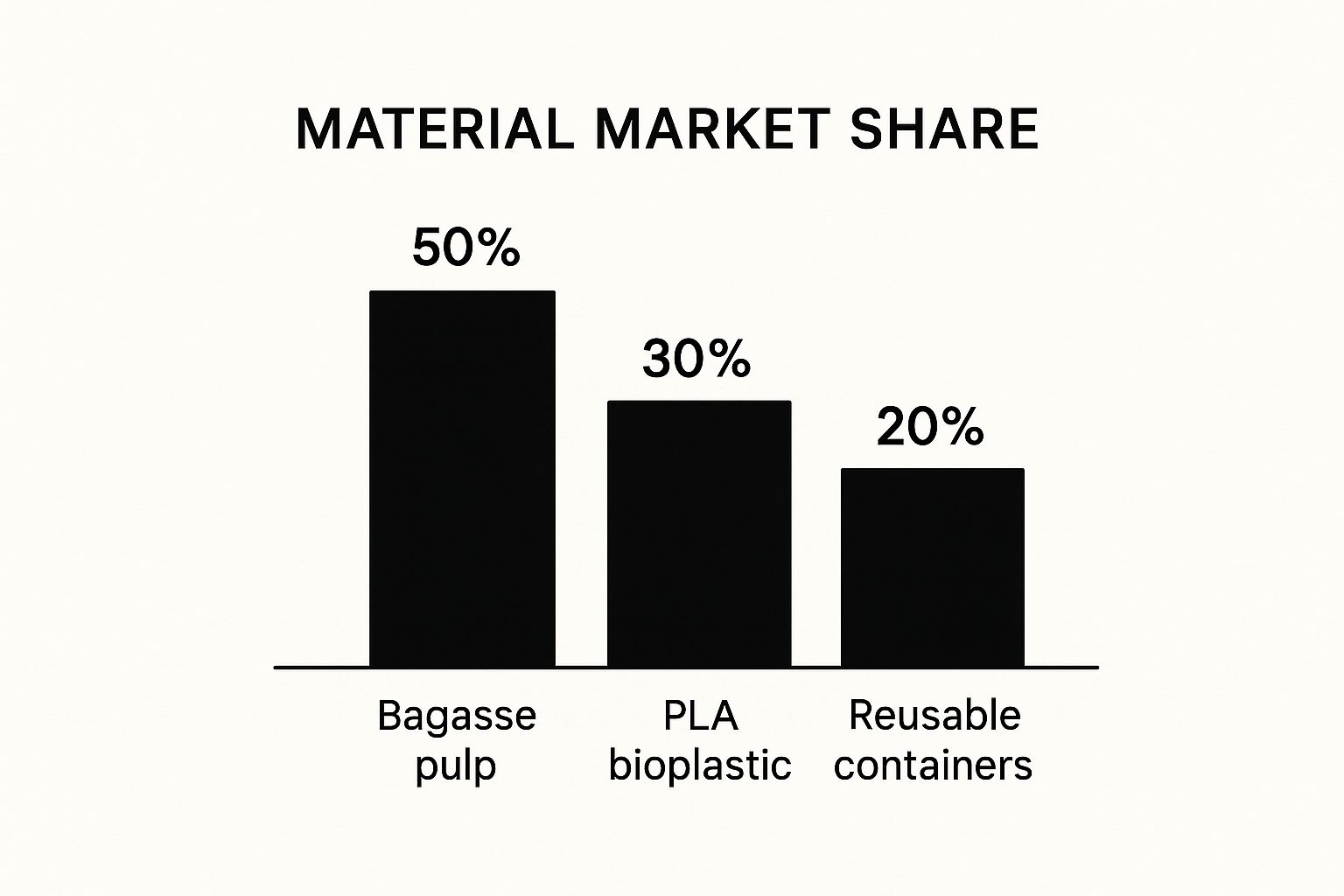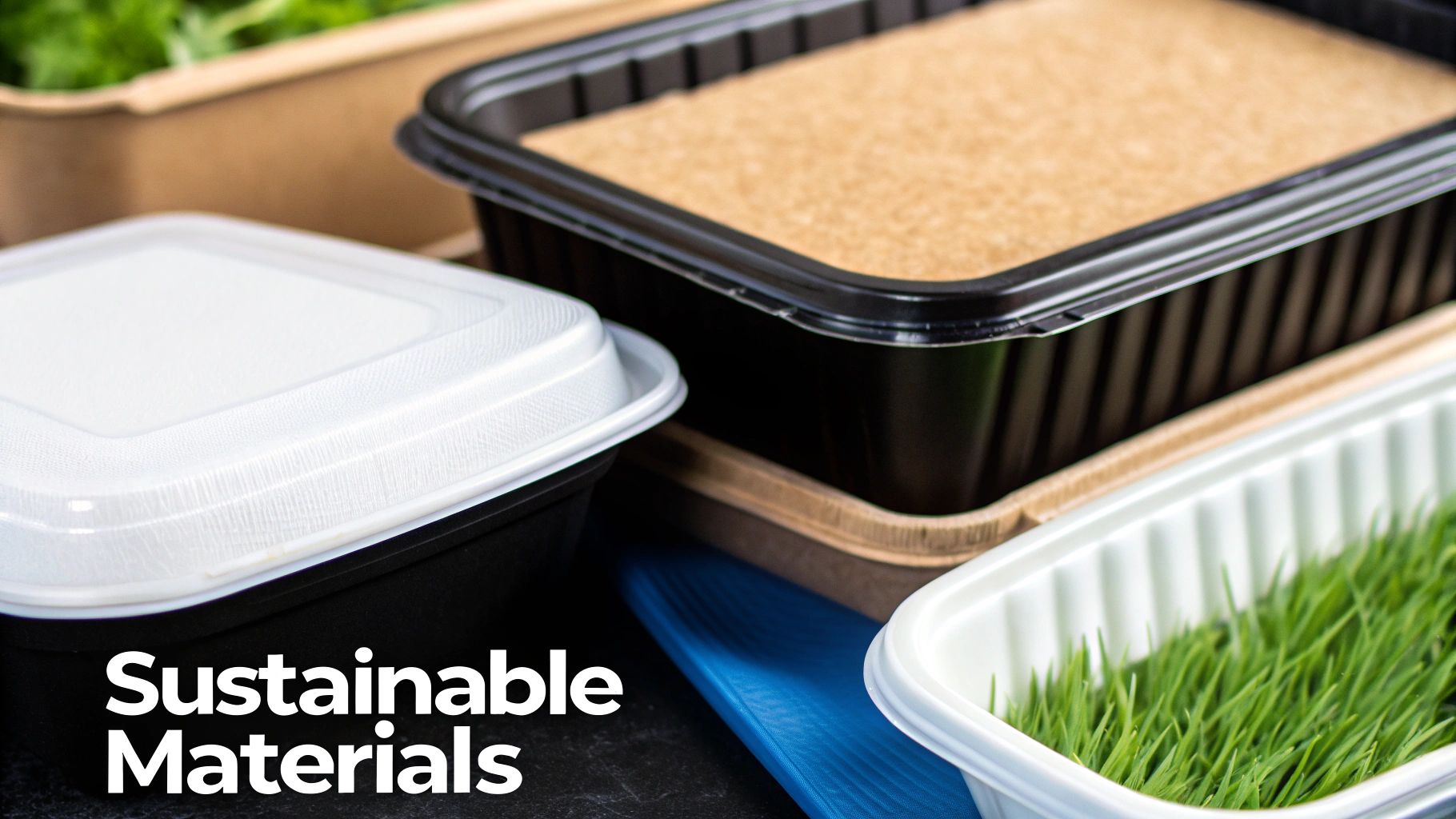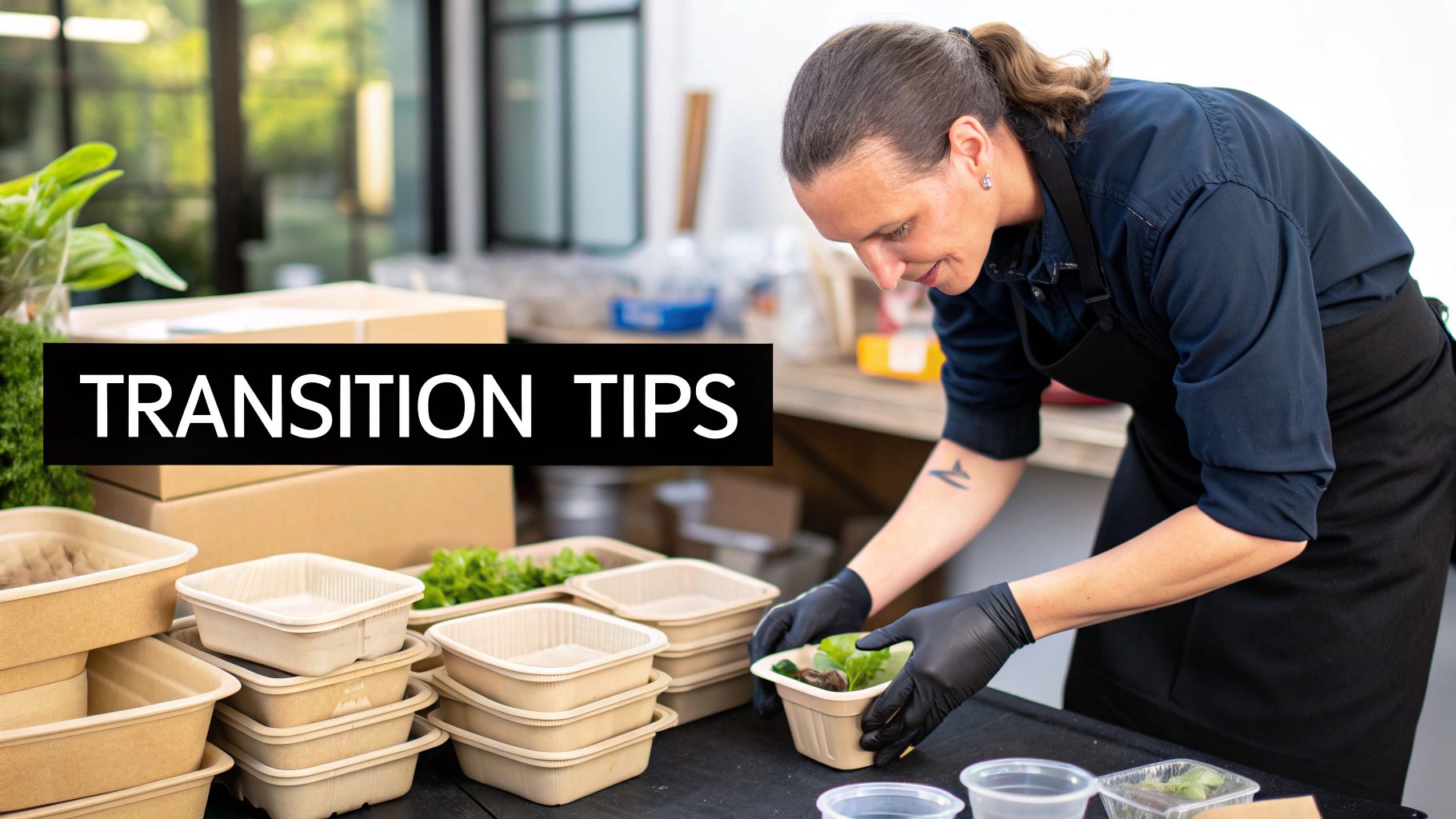Why Eco-Friendly Takeout Containers Are Transforming Food Service
For years, the food service industry relied heavily on traditional takeout containers like Styrofoam. These single-use plastics have a significant environmental impact, contributing to overflowing landfills and ocean pollution. This unsustainable practice has created a growing environmental crisis. However, consumers are increasingly aware of these issues and are actively seeking out more eco-conscious options, like eco friendly takeout containers
The Rise of the Eco-Conscious Consumer
Consumer awareness is changing the food service industry. More and more, people are making choices based on their values. Eco-friendly takeout containers are playing a key role in these decisions. Restaurants that embrace sustainability aren’t just attracting environmentally conscious customers; they’re building a reputation for responsible, forward-thinking practices. This fosters customer loyalty and strengthens brand image.
Navigating Regulations and Market Growth
Regulations are also driving the shift towards sustainability. The European Union’s ban on single-use plastics is a prime example. This legislation has accelerated the adoption of biodegradable and compostable alternatives, creating an urgent need for the industry to adapt. The market for eco-friendly takeout containers is experiencing significant growth.
The market expanded from approximately $12 billion in 2023 to a projected $26 billion by 2032. This represents a compound annual growth rate (CAGR) of roughly 9%. Regulations like the EU’s ban and increasing consumer demand, particularly in regions like China with large food delivery markets, are fueling this growth.
A Competitive Advantage for Businesses
Businesses that embrace these trends are gaining a competitive edge. They are using eco-friendly takeout containers not merely as a compliance requirement, but as a way to stand out. By providing sustainable packaging, they attract environmentally conscious customers and boost their brand reputation.
This proactive approach to sustainability is a smart marketing strategy. It resonates with the growing number of consumers who are willing to support businesses that prioritize the planet. This benefits the environment and positions businesses for long-term success in an increasingly eco-aware market.
The Truth About Sustainable Materials: What Actually Works
Consumers are increasingly looking for eco-friendly takeout containers. However, not every “green” option is as sustainable as it claims to be. Understanding the different materials is important for restaurants and consumers alike to make responsible choices. Some materials may seem sustainable on the surface, but a deeper look reveals hidden environmental impacts.
Biodegradable vs. Compostable: Understanding the Difference
Two terms – biodegradable and compostable – often create confusion. Biodegradable simply means a material will eventually break down. This breakdown can take a very long time, even decades, and might need very specific conditions. Compostable materials break down into organic matter much faster, typically within a few months, in a composting environment. This is a vital distinction when choosing truly eco-friendly takeout containers.
Evaluating Common Eco-Friendly Materials
Several materials are competing to be the best choice for sustainable packaging. Each has benefits and drawbacks:
- Bagasse (Sugarcane Pulp): A byproduct of sugarcane processing, bagasse is highly renewable and compostable. It works well for hot and cold foods, but might not be the best choice for very moist items.
- Bamboo: Bamboo grows incredibly fast and requires minimal resources, making it a seemingly sustainable choice. Bamboo containers are durable and attractive, but they often have to be shipped long distances, adding to their environmental footprint.
- PLA (Polylactic Acid): PLA is a bioplastic made from renewable resources like corn starch. It’s compostable in industrial composting facilities, but might not break down in home composting systems.
- Molded Fiber: Made from recycled paper and cardboard, this material is highly recyclable and often compostable. It’s a strong and adaptable option, but can sometimes be pricier than alternatives.
The Lifecycle Impact: From Sourcing to Disposal
The environmental impact of a material goes beyond just how it’s disposed of. Sourcing raw materials, the manufacturing process, and transportation distances all play a role in a material’s overall footprint. For instance, while bamboo is renewable, shipping it long distances may offset some of those environmental benefits.
To help visualize the environmental impact of different materials, the data chart below compares common takeout container materials across their entire lifecycle, from sourcing to disposal. This chart breaks down the energy consumption, greenhouse gas emissions, and water usage associated with each material.
As the chart clearly shows, bagasse and molded fiber have a significantly lower environmental impact than conventional plastics, primarily due to reduced energy needs and emissions. However, differences exist even among the eco-friendly options. Bamboo, as an example, shows higher greenhouse gas emissions than bagasse, highlighting the importance of understanding the entire lifecycle.
To further break down the characteristics of sustainable materials, let’s take a look at the following comparison table.
Eco-Friendly Container Materials Comparison
| Material | Biodegradability | Heat Resistance | Moisture Resistance | Cost Factor | Best For |
|---|---|---|---|---|---|
| Bagasse (Sugarcane Pulp) | High (Compostable) | Moderate | Low | Low to Moderate | Dry foods, hot or cold items |
| Bamboo | Moderate | High | Moderate | Moderate to High | Sturdy containers, aesthetically pleasing presentations |
| PLA (Polylactic Acid) | High (Compostable – Industrial) | Moderate | Moderate | Moderate | Cold foods, some hot applications (depending on grade) |
| Molded Fiber | High (Often Compostable) | Moderate | Moderate | Moderate to High | Versatile, variety of food types |
This comparison reveals the strengths and weaknesses of each material, helping businesses choose the best option for their specific needs.
How Different Markets Are Revolutionizing Takeout Packaging
The move toward eco-friendly takeout containers isn’t happening the same way everywhere. Different regions are adopting unique approaches based on their culture, local laws, and resources. This has created exciting new developments in the global food service industry. By examining these diverse approaches, businesses can gain valuable insights for improving their own sustainability.
Europe: Leading the Charge Through Regulation
Europe is a leader in sustainable packaging. Stringent regulations, like the EU’s 2021 Single-Use Plastics Directive, are the primary driver. This directive has significantly impacted the market for eco-friendly takeout containers, especially in Germany, the UK, and France, where there’s a growing demand for paper-based and compostable options. For example, the UK generates over 11 billion disposable food containers every year, putting immense pressure on businesses to adopt biodegradable alternatives. This focus on regulation presents both obstacles and opportunities.
Asia: Embracing Biodegradable Innovation
Asian markets are tackling the problem differently, emphasizing biodegradable materials. The rise of food delivery services in places like China, combined with government efforts to reduce plastic waste, has increased the demand for compostable packaging. Materials like bamboo and sugarcane pulp are gaining popularity. This innovative approach positions Asia as a major force in the global movement toward sustainable takeout.
Scandinavia: Pioneering Reusable Systems
Scandinavia is forging its own path, focusing on reusable container systems. This aligns with the region’s strong cultural emphasis on environmental responsibility. These systems usually involve deposit schemes and easy return options, motivating consumers to participate in a circular economy. This focus on reusability provides a unique solution to the takeout packaging challenge.
Cultural Influences on Packaging Design
Cultural eating habits also influence packaging trends. In some cultures, sharing meals is customary, which leads to multi-compartment containers. In other regions, individual portions are the norm, creating a demand for smaller, single-serving packaging. This demonstrates how cultural context directly affects packaging choices and innovation.
Turning Regional Challenges Into Advantages
Savvy businesses are adapting to these regional differences. They aren’t just following the rules; they’re seeing them as a chance to innovate. By understanding the particular needs of their local market, they’re developing tailored solutions that appeal to customers and strengthen their brand. This targeted approach allows businesses to turn regulatory hurdles into competitive edges. In short, focusing on regional needs in eco-friendly packaging isn’t just good for the environment; it’s good business.
Delivery Platforms: The Surprising Drivers of Packaging Change
Online food delivery platforms are quickly changing how restaurants view sustainable packaging. These platforms are becoming strong advocates for eco-friendly takeout containers, influencing both restaurants and consumers. This change is occurring more rapidly than many realize, with major platforms actively promoting sustainable options.
Incentivizing the Eco-Friendly Switch
Delivery apps are incentivizing restaurants to embrace sustainability in a few key ways. Preferential placement in search results is a strong motivator. Restaurants using eco-friendly takeout containers are often featured more prominently, attracting a larger customer base.
Some platforms partner with sustainable packaging suppliers, offering discounted rates to restaurants. This makes switching to eco-friendly options more affordable and easier to implement.
The Power of Customer Feedback
Customer feedback plays a vital role. Many platforms allow customers to rate their experience, including the packaging. Positive reviews for sustainable packaging can improve a restaurant’s rating and visibility.
This direct connection between customer satisfaction and search ranking encourages restaurants to choose eco-friendly takeout containers. Some apps even allow customers to filter search results by restaurants using sustainable practices. This empowers eco-conscious consumers and further incentivizes businesses to adapt.
Platform Partnerships and Sustainability Scores
Some delivery platforms are integrating sustainability scores into their algorithms. These scores, based on factors like a restaurant’s packaging choices and other sustainability efforts, influence search rankings and overall visibility.
Platforms also educate customers about the importance of sustainable packaging through in-app messages and promotional campaigns. This increases consumer awareness and reinforces the value of eco-friendly options.
Online food delivery platforms are becoming key drivers for eco-friendly packaging, representing a substantial portion of the $199.99 billion global eco-friendly food packaging market (2024), projected to reach $392.37 billion by 2034.
This shift is crucial as the foodservice industry faces increasing pressure to reduce packaging waste. Takeout containers contribute significantly to the 8 million tons of plastic that enter our oceans every year. Emerging innovations like plant-based liners for grease resistance and algae-derived materials are gaining traction, supported by corporate sustainability commitments from large chains aiming to eliminate single-use plastics by 2025-2030.
Leveraging Platform Dynamics for Success
Restaurants can use these platform dynamics to their advantage. By choosing eco-friendly takeout containers, restaurants can improve their visibility, attract environmentally conscious customers, and contribute to a more sustainable future.
This forward-thinking approach benefits both the environment and the restaurant’s bottom line. Restaurants can also highlight their commitment to sustainability through their platform presence, strengthening their brand image and creating positive outcomes for businesses, consumers, and the planet.
The 10 Most Effective Eco Friendly Takeout Containers
Choosing the right eco-friendly takeout containers can be a challenge for any business. This guide breaks down the most effective options, focusing on practical performance and customer experience. We’ll move past marketing hype and examine what truly delivers, from how well containers protect food during delivery to how customers perceive them. Ultimately, the goal is to strike a balance between sustainability and practicality.
Understanding Your Needs: Matching Containers to Food
Different foods require different packaging. A crisp salad needs a container that prevents sogginess, while hot soup demands a leak-proof and insulated solution. Matching the container to your menu is key for customer satisfaction and minimizing food waste. Think about factors like temperature, moisture content, and the food’s structural integrity.
Top 10 Eco-Friendly Takeout Container Options
Here are ten effective eco-friendly takeout containers categorized by material:
Plant-Based:
- Bagasse (Sugarcane Pulp): These compostable containers are excellent for dry, hot, or cold foods. However, avoid using them for excessively oily or saucy dishes.
- Bamboo: Durable and aesthetically pleasing, bamboo containers are versatile. Keep in mind, though, that they can be more expensive and may require longer shipping distances.
- Palm Leaf: These compostable, sturdy containers work well for both hot and cold items, presenting a natural and attractive appearance.
- PLA-lined Paperboard: This option combines the strength of paperboard with the leak resistance of a PLA lining, suitable for a wider variety of foods, including liquids.
Wood-Based:
- Molded Fiber (Recycled Paperboard): This strong and versatile material is a good option for various food types, offering recyclability and often compostability.
Bioplastics:
- PLA (Polylactic Acid): PLA is compostable in industrial composting facilities but is best suited for cold or moderately hot foods. Check its compostability in your area.
Other Innovative Materials:
- Mushroom Packaging: Mycelium, the root structure of mushrooms, offers a promising compostable and insulating packaging solution. While still relatively new, it’s definitely a material to keep an eye on.
- Seaweed Packaging: Biodegradable seaweed-based films can be used as liners or wraps, reducing the need for traditional plastics.
Reusable Options:
- Stainless Steel: Durable stainless steel containers are ideal for reusable programs, providing excellent temperature resistance and a premium feel.
- Glass: Glass containers are another reusable option, offering visibility and temperature resistance. However, their weight and breakability should be considered.
To help you compare these options, we’ve compiled a table highlighting their key features:
Top 10 Eco-Friendly Takeout Containers Analysis
| Container Type | Environmental Impact Score | Durability | Food Compatibility | Cost Range | Consumer Preference Rating |
|---|---|---|---|---|---|
| Bagasse (Sugarcane Pulp) | 9 | 7 | 7 | Low | 8 |
| Bamboo | 8 | 9 | 8 | High | 9 |
| Palm Leaf | 9 | 8 | 8 | Medium | 8 |
| PLA-lined Paperboard | 7 | 8 | 9 | Medium | 7 |
| Molded Fiber (Recycled Paperboard) | 8 | 8 | 8 | Medium | 8 |
| PLA (Polylactic Acid) | 7 | 6 | 7 | Low | 6 |
| Mushroom Packaging | 9 | 6 | 7 | Medium | 7 |
| Seaweed Packaging | 9 | 5 | 6 | High | 6 |
| Stainless Steel | 6 | 10 | 10 | High | 9 |
| Glass | 6 | 8 | 9 | Medium | 8 |
This table offers a quick comparison of various eco-friendly takeout container options. Note that consumer preference can be influenced by factors such as perceived quality and brand image.
Operational Considerations: Choosing the Right Fit
Beyond the material itself, several practical factors influence a container’s effectiveness:
- Lid Design: A secure lid is essential for spill prevention and maintaining food quality during delivery. Vented lids are a good option for hot foods.
- Stackability: Efficient storage is crucial for restaurants. Choose containers that stack well to maximize space.
- Cost: Eco-friendly containers can sometimes be more expensive than traditional options. Balancing cost with sustainability is a key business decision.
Leading Restaurants Setting the Standard
Many restaurants are successfully incorporating eco-friendly takeout containers to boost their sustainability and brand image. Some use bagasse for salads and sandwiches, while others prefer molded fiber for hot entrees. By highlighting their commitment to eco-friendly practices, these businesses appeal to environmentally conscious consumers.
The Future of Eco-Friendly Takeout
As technology advances, expect even more innovative and effective eco-friendly takeout containers. These developments promise improved performance and sustainability, further reshaping the food service industry. Choosing sustainable takeout packaging is no longer just a trend; it’s a responsible business practice.
Making the Switch Without Breaking the Bank
Switching to eco-friendly takeout containers can seem intimidating because of the perceived cost. However, there are practical strategies to make the transition without sacrificing your profits. This section explores how to embrace sustainable packaging affordably. We’ll cover cost-effective options, smart negotiation tactics with suppliers, and how to effectively communicate your green initiatives to your customers.
Phasing In Eco-Friendly Options
A complete, overnight change isn’t always necessary. Consider gradually introducing eco-friendly takeout containers into your operations. You could start with a single menu item or a specific customer segment, like online orders. This phased approach allows you to gauge customer feedback, manage inventory effectively, and adjust your strategy as you go, minimizing initial investment and ensuring a smoother transition.
Negotiating With Suppliers and Leveraging Bulk Purchasing
Negotiating with suppliers is essential. Don’t hesitate to compare prices from different vendors. Look for suppliers offering bulk discounts or long-term contract savings. Consider partnering with other restaurants to leverage joint purchasing power and achieve greater cost savings. Also, think about the value-to-sustainability ratio: some containers provide a better balance of environmental benefit and price.
Communicating Your Eco-Commitment to Customers
Communicate your switch to eco-friendly takeout containers. Many customers value environmental responsibility and will support businesses that prioritize sustainability. Highlight your efforts on your menu, website, and social media platforms. You could even add a small premium to menu items using sustainable packaging to offset some of the extra cost. Transparency builds trust and reinforces your brand’s values.
Container Options for Maximum Value
Selecting the right containers is key. Bagasse (sugarcane pulp) containers are often a cost-effective and compostable option for various food types. Molded fiber, made from recycled materials, provides another affordable and versatile choice. For items needing a stronger barrier against leaks, consider PLA-lined paperboard to balance cost and performance. Each option offers a different balance of sustainability and cost-effectiveness, allowing you to tailor your packaging to your budget.
Analyzing Long-Term ROI
Look beyond the initial expense. Switching to eco-friendly takeout containers can generate long-term benefits, like increased customer loyalty and a positive brand image. These intangible benefits contribute to the overall return on investment (ROI). While the upfront cost of sustainable packaging might be higher, the potential long-term gains can more than compensate for this, making it a sound business decision.
Practical Tips for Reducing Costs
- Optimize container sizes: Using the right-sized container reduces waste and material costs. Avoid a “one-size-fits-all” approach.
- Explore reusable container programs: While requiring an initial investment, reusable programs can offer substantial long-term savings and attract environmentally conscious customers.
- Educate staff: Training staff on proper packaging procedures minimizes waste and maximizes the use of each container, while also equipping them to answer customer questions.
By strategically implementing these approaches, businesses can embrace sustainability without compromising their bottom line. The shift to eco-friendly takeout containers is a worthwhile investment that benefits both the environment and your business’s future.
Tomorrow’s Takeout: Emerging Innovations Worth Watching
The world of eco-friendly takeout containers is constantly changing. While options like bagasse and molded fiber are readily available, exciting new technologies are emerging. These innovations aim to resolve current issues and minimize the environmental footprint of takeout packaging.
Mycelium: From Mushrooms to Packaging
Mycelium, the root-like structure of mushrooms, is garnering significant interest as a sustainable packaging material. It’s cultivated using agricultural waste products, making it a remarkably resource-efficient choice. Researchers are currently exploring ways to improve mycelium’s resistance to heat, expanding its potential use for hot food containers. As a natural material, mycelium is fully compostable, breaking down harmlessly back into the earth.
Seaweed: A Solution for Water Resistance
Seaweed-based materials offer solutions to a key challenge in eco-friendly takeout containers: water resistance. Seaweed can be transformed into films and coatings, creating a natural moisture barrier. This biodegradable material provides a viable replacement for traditional plastic liners, ultimately improving the functionality of eco-friendly packaging.
Circular Economy Models: Rethinking Packaging Lifecycles
Circular economy models are gaining traction in the packaging industry. These models emphasize reuse and recycling to minimize waste and maximize resource utilization. Some companies are developing reusable container systems for takeout, which often incorporate deposit schemes to incentivize customers to return containers. This model signals a major shift away from single-use packaging.
Addressing Current Pain Points
These innovations are actively tackling the drawbacks of current eco-friendly takeout containers. For instance, the low heat resistance of some plant-based materials is being addressed with advancements in mycelium technology. Seaweed-based materials provide superior water resistance compared to conventional compostable alternatives. These developments pave the way for more practical and user-friendly eco-friendly packaging.
Positioning Your Business for the Future
Keeping up with these emerging innovations is crucial for businesses in the food service industry. Understanding which technologies are nearing commercial viability allows for proactive planning and transitioning to more sustainable packaging options. Early adoption of these solutions can give your business a competitive edge by attracting environmentally conscious customers.
Looking for reliable and sustainable takeout packaging solutions right now? Visit MrTakeOutBags.com for a diverse selection of eco-friendly products.







Comments are closed.